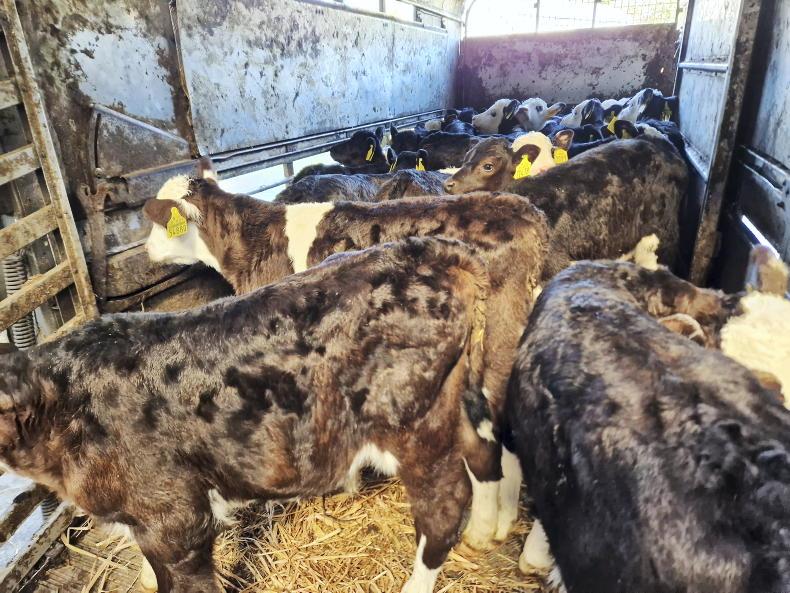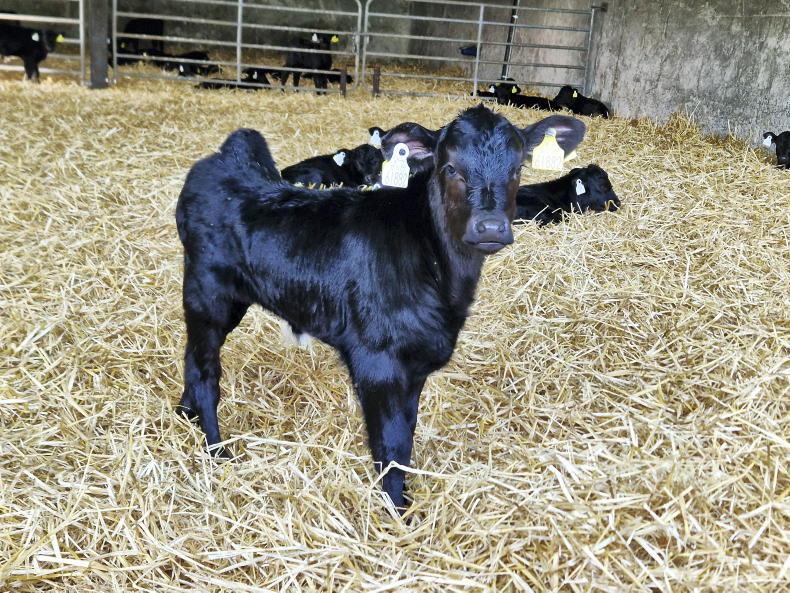Each year the Thrive demonstration farm outside Cashel, Co Tipperary purchases in around 140 calves to be reared.
The aim is to assemble these calves as early in spring as possible to help ensure that stock are fit to be slaughtered off grass at the end of the second grazing season.

Calves coming off the trailer on arrival to the demo farm. The trailer is always well bedded for stock.
As well as this, we are trying to balance the price paid for calves as there is a strong relationship between calf price and the overall profitability of diary beef systems.
Pay too much on day one, and no matter what the performance or management of feed costs might be from that point onwards, it can be nearly impossible to leave a positive margin.
Calf breed
Over the last number of years on the demonstration farm a mixture of breeds have been reared, including Angus, Hereford, Limousin, Belgian Blue, Aubrac, Charolais and Simmental.
However, this year the number of continental calves has dropped even further due to availability and price.
Angus and Hereford will make up more than 80% of the calves on farm this year
This is not something we are overly worried about as in recent years the early-maturing systems have come out on top in terms of net margin.
It is also a reflection on the availability of calves out there in the marketplace. Angus and Hereford will make up more than 80% of the calves on farm this year.
Across the rest of the Thrive farms throughout the country, most are operating systems using early-maturing breeds.
The reason for this is that they are cheaper to purchase on day one, and they are more suited to finishing off grass without the need for an expensive indoor winter finishing period.
Calf price
Reported calf prices in the marts have fallen sharply over the last fortnight, back as much as €40/head in this timeframe.
However, within this average price there is a huge variation. Good-quality calves are still a good trade, and while they have come back somewhat in recent weeks, it is not to the same extent as the overall average price.
Calf buyers need to be careful that they do not see a cheap calf as a bargain – it could be the most costly calf in the long run.
As we reported in recent weeks, as much as 11% of the stock from the demonstration farm failed to maximise the “in-spec” carcase payment last year.
These are calves from high genetic merit beef sires and from herds where the cow type is known. Where inferior-quality sires are used or where cow type may be more extreme, this figure falling out of spec is likely to be greater.

Keep bedding topped up at all times. Calves will spend the majority of the day lying down.
The average early-maturing heifer price on the demo farm this year is €188/head at between two and three weeks old. For bulls the same age the average price has been €210/head over the last three weeks.
Pneumonia warning
Speaking to a number of farmers rearing calves in recent days, many have seen a spike in the instances of pneumonia in the rearing shed. This is likely due to large swings in temperature between day and night.

A healthy calf will always stretch when put up after a period of lying down.
Colder weather conditions forecast in the coming days will also have an effect on calf health. Keep bedding deep and dry at all times. Eliminate any draughts at calf level – under gates and doorways are common problem areas. A well-placed bale of straw can do a lot to eliminate draughts in doorways.
Check any calf that is slow to come to feed or looks any way off form straight away. A thermometer should be kept at hand at all times when in the calf shed.
Read more
11% of stock fail to maximise in-spec carcase bonus
Thrive: getting yearling stock to grass
Grass+ Beef: changeable weather needs careful attention
Each year the Thrive demonstration farm outside Cashel, Co Tipperary purchases in around 140 calves to be reared.
The aim is to assemble these calves as early in spring as possible to help ensure that stock are fit to be slaughtered off grass at the end of the second grazing season.

Calves coming off the trailer on arrival to the demo farm. The trailer is always well bedded for stock.
As well as this, we are trying to balance the price paid for calves as there is a strong relationship between calf price and the overall profitability of diary beef systems.
Pay too much on day one, and no matter what the performance or management of feed costs might be from that point onwards, it can be nearly impossible to leave a positive margin.
Calf breed
Over the last number of years on the demonstration farm a mixture of breeds have been reared, including Angus, Hereford, Limousin, Belgian Blue, Aubrac, Charolais and Simmental.
However, this year the number of continental calves has dropped even further due to availability and price.
Angus and Hereford will make up more than 80% of the calves on farm this year
This is not something we are overly worried about as in recent years the early-maturing systems have come out on top in terms of net margin.
It is also a reflection on the availability of calves out there in the marketplace. Angus and Hereford will make up more than 80% of the calves on farm this year.
Across the rest of the Thrive farms throughout the country, most are operating systems using early-maturing breeds.
The reason for this is that they are cheaper to purchase on day one, and they are more suited to finishing off grass without the need for an expensive indoor winter finishing period.
Calf price
Reported calf prices in the marts have fallen sharply over the last fortnight, back as much as €40/head in this timeframe.
However, within this average price there is a huge variation. Good-quality calves are still a good trade, and while they have come back somewhat in recent weeks, it is not to the same extent as the overall average price.
Calf buyers need to be careful that they do not see a cheap calf as a bargain – it could be the most costly calf in the long run.
As we reported in recent weeks, as much as 11% of the stock from the demonstration farm failed to maximise the “in-spec” carcase payment last year.
These are calves from high genetic merit beef sires and from herds where the cow type is known. Where inferior-quality sires are used or where cow type may be more extreme, this figure falling out of spec is likely to be greater.

Keep bedding topped up at all times. Calves will spend the majority of the day lying down.
The average early-maturing heifer price on the demo farm this year is €188/head at between two and three weeks old. For bulls the same age the average price has been €210/head over the last three weeks.
Pneumonia warning
Speaking to a number of farmers rearing calves in recent days, many have seen a spike in the instances of pneumonia in the rearing shed. This is likely due to large swings in temperature between day and night.

A healthy calf will always stretch when put up after a period of lying down.
Colder weather conditions forecast in the coming days will also have an effect on calf health. Keep bedding deep and dry at all times. Eliminate any draughts at calf level – under gates and doorways are common problem areas. A well-placed bale of straw can do a lot to eliminate draughts in doorways.
Check any calf that is slow to come to feed or looks any way off form straight away. A thermometer should be kept at hand at all times when in the calf shed.
Read more
11% of stock fail to maximise in-spec carcase bonus
Thrive: getting yearling stock to grass
Grass+ Beef: changeable weather needs careful attention









 This is a subscriber-only article
This is a subscriber-only article










SHARING OPTIONS: